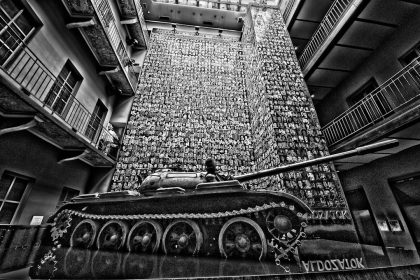

CONTACT US
1052 Budapest, Jane Haining Quay, Dock 11.
Customer support is available daily from 9:00 to 22:00.
Budapest, Jane Haining Quay, Dokk 11, 1052

As the other nation’s past, Hungarian history has also brighter and darker periods. The house of terror shows one of the darkest ones.
The building is in the Andrássy út under the 60th number. At the end of the second world war, the members of the Arrow Cross party (Hungarian Nazis) possessed it. In 1945, the Hungarian Communists occupied the building and they possessed it until the revolution in 1956. During the Communist regime, several innocent people were tortured there because the regime named their enemies. The Communist regime ended in the country in 1989, but the historical building had to wait for more than a decade. It was created into a museum and memorial place in 2002.

The exhibitions of the terror house demonstrate the suffering of several classes of society. In the first floor, a special labyrinth symbolizes the suffering of the peasants, who were deprived of their little land and the last piece of corn. In the second floor, maps, photos, and reminiscences tell about the horrors of the GULAG. The Church and religious people were also persecuted. Among other mementos, you can see a famous victim’s sacra mantle. He was an archbishop and called József Mindszenty.
You can flash a glance at the life of some Communist leaders. First of all, the organizers of the exhibition have recreated Gábor Péter’s workroom on the base of photos and written or verbal descriptions. He was the head of the State Protection Authority (in Hungarian AVH). In the room, you can see his really decorated table and a very plain, wooden doss. Life is sometimes fair, we can say, because he was also executed in a big political cleansing. One more group of interesting items is the little displays via which survivors tell about the methods of torment. However, they are not only innocent victims but also interrogators themselves.
Do you want to more about the torment? If you find the information received from the displays not enough, let’s visit the torture-chamber. This is the only room in the museum which is not reconstruction but it has served its original condition. On the wall, you can see barbed rods and other cruel weapons. The basement offers a similar, but – if it is possible – more shocking experience. You can learn what was the method of execution, and also can learn about the several kinds of cells which were extremely small or partially flooded with water. In the ‘Chamber of tears’ you can read the list of the victims’ names, and in another chamber, there are the nominal roll and photos of the people who were responsible for all these tragedies.
It is not a well-known fact, but the second floor also shows the terror and chaos caused by the Arrow Cross party in 1944.

In another room of the museum of terror, you can find lots of interesting documents about the concept lawsuits, while you can see the film records about the lawsuit of Imre Nagy. He was also a Communist leader but he had a role in the revolution in 1956 and was executed because of this role. An individual room is devoted to this revolution, and another one is to the retaliation.
Anyway, it was only a brief preview; there are several further sad, frightening, or interesting exhibitions in the museum. For example, you can see mementos in connection with the methods of propaganda or the effects of the Communist ideology and regime on everyday life.
If you are interested in this shocking but interesting period of Hungarian history, don’t miss the house of terror Budapest, which is also popular among the foreign tourists. On the 25th of February, the museum is often free, because in Hungary this day is devoted to the victims of the Communism.